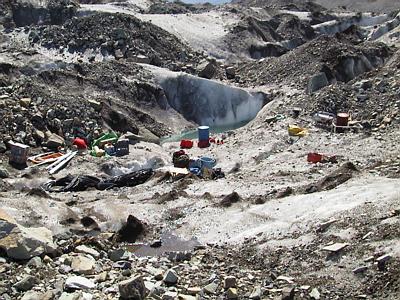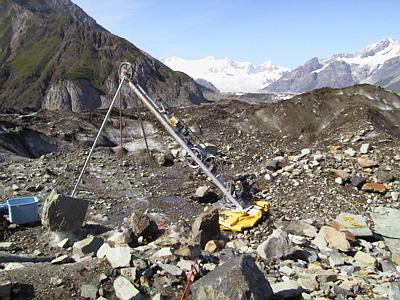
|
|
14 July, 1999
July 14
Things are hopping now! The hot water drill, which is used to drill through
the ice to the bed of the glacier, was set up by University of Wyoming
post-doc Joel Harper, and PSU grad student Don Lindsay. The drill is
operational and easily drilled a trial run of 15 meters. Steve Malone
(University of Washington seismologist) and I set up two seismometers in the
ice to record any movements of the ice related to the deflection of the ice
dam and to record any shuddering of the ice due to sudden changes in
sub-glacial hydraulic pressure. Joe Walder (USGS, Vancouver) and Michelle
Cunico (PSU grad student) made their way to Hidden Creek Lake basin,
inflated their water craft, and did a trial launch onto the water. St. Olaf
undergrad Andrew Malm ran a couple of ice radar lines (using ground
penetrating radar equipment) to estimate the depth to the bed of the
glacier. Dennis Trabant (USGS, Fairbanks) and I placed survey reflectors
onto the dam. Everyone encountered problems in their equipment and set up.
It was a day to work out glitches.
It was an exciting moment when the drill began making progress through the
ice. Setting up and operating the hot water drill is as follows. The
equipment consists of a sump pump, a heating plant, a power plant, hose
which can handle high temperature water, and a large boom supported by two
legs which feeds the hose into the hole. The sump pump is used to get water
from a nearby source of clean water to the heating plant. The heating plant
has a series of coils through which the water passes to be heated by
diesel-fired flames. The power plant consists of a generator which
provides electricity to the sump pump, a smaller pump which feeds the water
into the heating plant, and a motor which lowers the hot water hose into the
hole. The hose, of which there is 600 meters in length, is made of a
durable plastic which is insulated with fiberglass. The tripod has two legs
which support (prop up) a drilling boom. The drilling monument has an
attached motor which drives the hose through a series of wheels (also
attached to the boom) and into the hole. So, the process, in the end, is
quite simple. Water is accessed from a nearby pool, and is pumped into the
heating plant. After being heated to 240 degrees farenheit, the hot water
makes its way through the hose to the drill tip (appropriately called a
stinger in this case). The hot water extruded from the stinger is expected
to melt its way through the glacier. If a rock is encountered, the hose
will be backed out, and a new hole will be started.
It is possible that the drill will pass through an englacial conduit. An
englacial conduit is a channel which drains water from the surface, into,
and through the glacier. It is expected that numerous englacial conduits
exist in glaciers which are undergoing active melting, such as the Kennicott
Glacier. The presence of an englacial conduit bisecting the hole will
affect the pressure transducer measurements in the hole. So, after a hole
is drilled, a borehole video camera will be lowered into the hole to look
for these features. Hopefully drilling tomorrow will take us to the bed of
the glacier.
The Kennicott Glacier (as with most glaciers in Alaska) is a temperate
valley glacier. Being a valley glacier, snow accumulates and adds to the
mass of the glacier in the high mountain peaks. From the flanks of these
peaks the glaciers flow down and into adjacent valleys. As temperate
glaciers, they flow down to elevations where temperatures exceed the melting
temperature of the ice during the summer. This is where active melting
(called ablation) occurs. The portion of temperate glaciers which extend
into the lower elevation valleys are sopping wet during the summer. Water
flows across the surface, pools into meltwater ponds and lakes, and
sometimes flows into the interior of the glacier via moulons, and other
englacial conduits. In addition, by the time the glacier has flowed into
the valleys they have passed by adjacent rocky outcroppings. Rocks fall
from these outcrops and onto the glacier and are transported down the
valley. So, the lower tongue of a temperate valley glacier is wet and
commonly mantled with rocks. That is the case with the Kennicott Glacier.
By the time the glacier reaches its terminus at McCarthy, it looks more like
a rock pile.
_______________________________________________________________
Get Free Email and Do More On The Web. Visit http://www.msn.com

Driller Joel Harper is guiding the hot water hose into the borehole.

The drilling site. The "heating plant", which heats water to 240 degrees Fahrenheit, is located in the right side of the picture. Water to be heated was pumped from the pool in the center of the picture. The 55-gallon drums contain diesel (located adjacent to the pool and the heating plant), which is the primary fuel source for the power plant (heater and electrical generators). The photograph was taken from the spot where the borehole was eventually drilled.

The site of the first borehole. The brass "stinger" is hanging ready to extrude hot water into the underlying ice, melting its way toward the glacier bed.
Contact the TEA in the field at
.
If you cannot connect through your browser, copy the
TEA's e-mail address in the "To:" line of
your favorite e-mail package.
|
